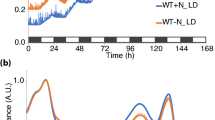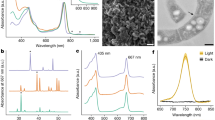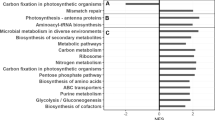Abstract
Among nitrogen-fixing microorganisms, nitrogen-fixing cyanobacteria are unique in their ability to carry out oxygen-evolving photosynthesis and oxygen-labile nitrogen fixation within the same organisms1–3. These seemingly incompatible reactions take place in heterocystous cyanobacteria by the spatial separation of the site of nitrogen fixation (heterocysts) from the site of photosynthesis (vegetative cells)4,5. Several hypotheses have been proposed to explain these mechanisms in non-heterocystous cyanobacteria3,6–11. Using batch cultures of Gloeothece (Gloeocapsa) spp., Gallon and collaborators demonstrated the mechanism of temporal separation of photosynthesis and nitrogen fixation into the light and dark periods of growth, respectively9. However, the mechanisms by which these two incompatible reactions can occur under continuous light conditions still remained ambiguous. Using novel strains of aerobic nitrogen-fixing, unicellular marine cyanobacteria, Synechococcus spp., grown under synchronized conditions, we report here that nitrogen fixation and photosynthesis occur at different phases in the cell division cycle. Our data, obtained under both diurnal light/dark cycle and continuous illumination, indicate that the temporal separation of the two phases during the cell division cycle is the mechanism by which these unicells can grow photoautotrophically under nitrogen-fixing conditions.
This is a preview of subscription content, access via your institution
Access options
Subscribe to this journal
Receive 51 print issues and online access
$199.00 per year
only $3.90 per issue
Buy this article
- Purchase on Springer Link
- Instant access to full article PDF
Prices may be subject to local taxes which are calculated during checkout
Similar content being viewed by others
References
Stanier, R. Y. & Cohen-Bazire, G. A. Rev. Microbiol. 31, 225–274 (1977).
Stewart, W. D. P. A. Rev. Microbiol. 34, 497–536 (1980).
Gallon, J. R. Trends biochem. Sci. 6, 19–23 (1981).
Haselkorn, R. A. Rev. Plant Physiol. 29, 319–344 (1978).
Fay, P. in Recent Advances in Biological Nitrogen Fixation (ed. Subba Rao, N. S.) 121–165 (Arnold, London, 1980).
Fay, P., Kumar, H. D. & Fogg, G. E. J. gen. Microbiol. 35, 351–360 (1964).
Gallon, J. R., LaRue, T. A. & Kurz, W. G. W. Can. J. Microbiol. 20, 1633–1637 (1974).
Weare, N. M. & Benemann, J. R. J. Bact. 119, 258–265 (1974).
Mullineaux, P. M., Gallon, J. R. & Chaplin, A. E. FEMS Microbiol. Lett. 10, 245–247 (1981).
Kallas, T. et al. in Photosynthetic Prokaryotes: Cell Differentiation and Function (eds Papageorgiou, G. C. & Packer, L.) 281–302 (Elsevier, New York, 1983).
Stal, L. J. & Krumbein, W. E. Archs Microbiol. 143, 67–71 (1985).
Mitsui, A. in Proc. 5th Int. Ocean Dev. Conf. 1(B1), 29–52 (Seino, Tokyo, 1978).
Mitsui, A. et al. Ann. N. Y. Acad. Sci. 413, 514–530 (1983).
Mitsui, A. et al. in Biotechnology and Bioprocess Engineering (ed. Ghose, T. K.) 119–155 (United India, New Delhi, 1985).
Gallon, J. R. & Hamadi, A. F. J. gen. Microbiol. 130, 495–503 (1984).
Sandmann, G. & Malkin, R. Archs biochem. Biophys. 234, 105–111 (1984).
Smith, A. J. in The Biology of Cyanobacteria (eds Carr, N. G. & Whitton, B. A.) 47–85 (University of California Press, Berkeley, 1982).
Mitsui, A., Takahasi, A., Ikemoto, H., Cao, S. & Arai, T. 5th Int. Symp. Photosynth. Prokaryotes, Abstr. 63 (Grindelwald, Switzerland, 1985).
Mullineaux, P. M., Chaplin, A. E. & Gallon, J. R. J. gen Microbiol. 120, 227–232 (1980).
Kumazawa, S. & Mitsui, A. Int. J. Hydrogen Energy 6, 339–348 (1981).
Ernst, A. & Böger, P. J. gen. Microbiol. 131, 3147–3153 (1985).
Chaplin, A. E. & Gallon, J. R. 5th Int. Symp. Photosynth. Prokaryotes Abstr. 253 (Grindelwald, Switzerland, 1985).
Stal, L. J. & Krumbein, W. E. Archs Microbiol. 143, 72–76 (1985).
León, C., Kumazawa, S. & Mitsui, A. Curr. Microbiol. 13, 149–153 (1986).
Kumazawa, S. & Mitsui, A. Appl. environ. Microbiol. 50, 287–291 (1985).
Dubois, M., Gilles, K. A., Hamilton, J. K., Rebers, P. A. & Smith, F. Analyt. Chem. 28, 350–356 (1956).
Author information
Authors and Affiliations
Rights and permissions
About this article
Cite this article
Mitsui, A., Kumazawa, S., Takahashi, A. et al. Strategy by which nitrogen-fixing unicellular cyanobacteria grow photoautotrophically. Nature 323, 720–722 (1986). https://doi.org/10.1038/323720a0
Received:
Accepted:
Issue Date:
DOI: https://doi.org/10.1038/323720a0
This article is cited by
-
Frequency of change determines effectiveness of microbial response strategies
The ISME Journal (2023)
-
Circadian clock-controlled gene expression in co-cultured, mat-forming cyanobacteria
Scientific Reports (2020)
-
Novel unexpected functions of PHA granules
Applied Microbiology and Biotechnology (2020)
-
Genome analysis of the freshwater planktonic Vulcanococcus limneticus sp. nov. reveals horizontal transfer of nitrogenase operon and alternative pathways of nitrogen utilization
BMC Genomics (2018)
-
Functional expression of an oxygen-labile nitrogenase in an oxygenic photosynthetic organism
Scientific Reports (2018)
Comments
By submitting a comment you agree to abide by our Terms and Community Guidelines. If you find something abusive or that does not comply with our terms or guidelines please flag it as inappropriate.



